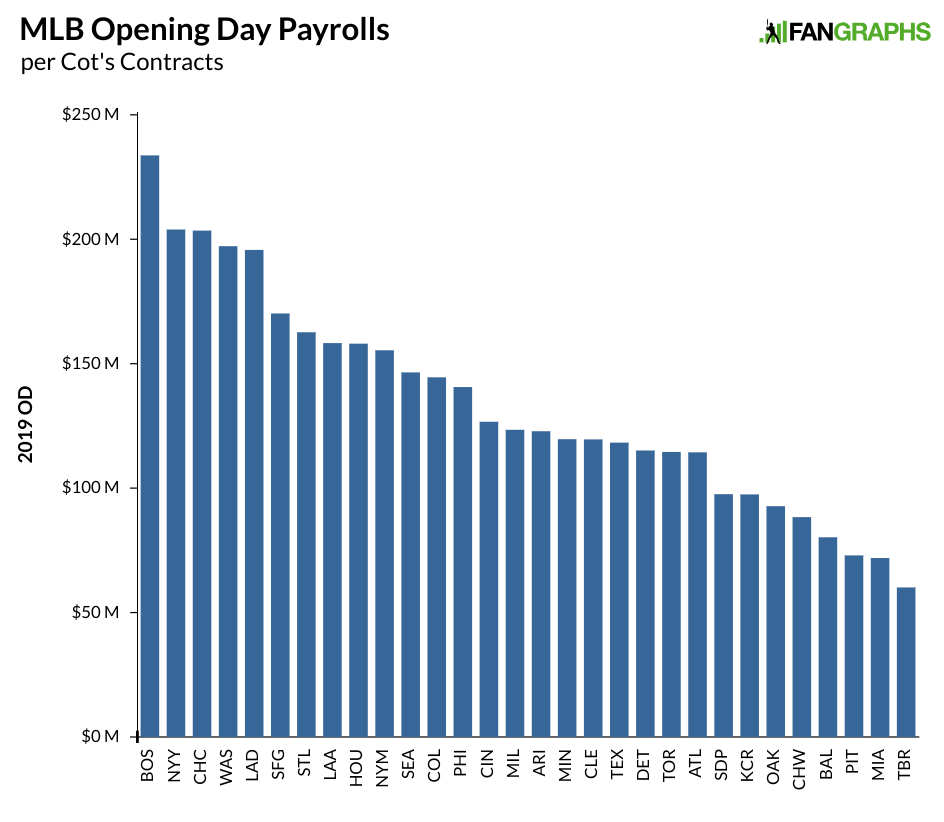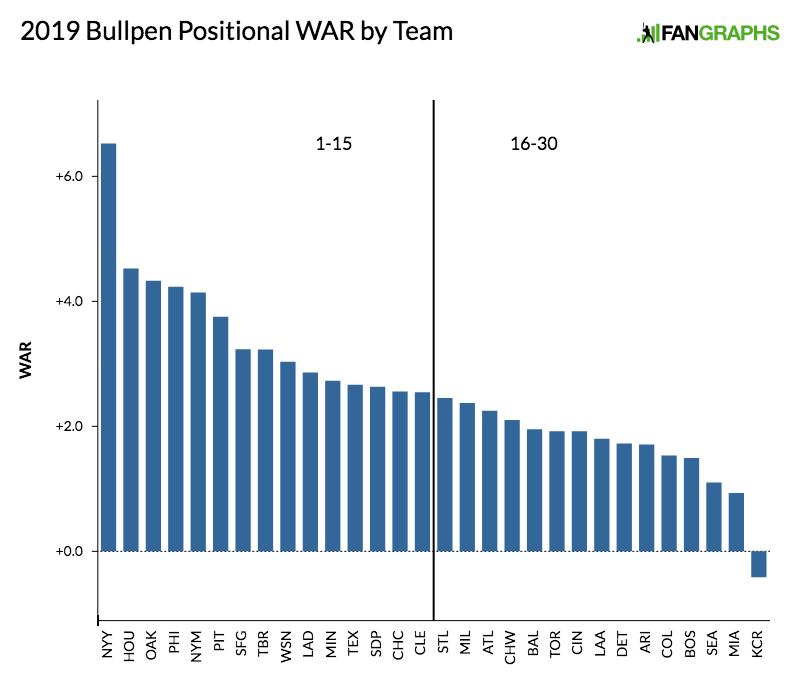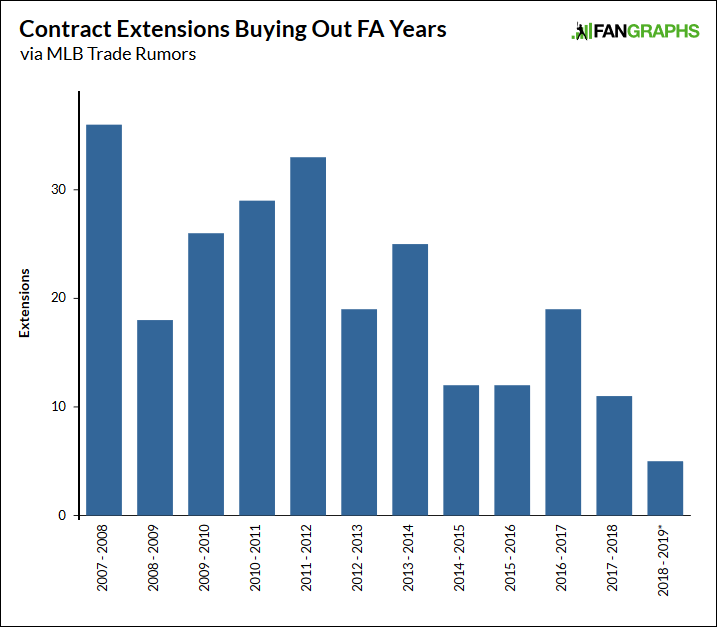In November, I published the results of my research attempting to put a value on minor league prospects. It seems only natural that a similar study on draft picks should follow.
As with prospect valuations, considerable work has preceded mine in the area of valuing draft picks. Sky Andrechuk, Victor Wang, Matthew Murphy, Jeff Zimmerman, and Anthony Rescan and Martin Alonso have all done similar studies.
The work below is less a replacement of the work already done and is more of a continuation of, and addition to, the study of the subject matter. As to why we might want to know this information, creating an expected value for a draft pick helps us to understand and manage our expectations of draftees’ performance. More practically, teams regularly give up draft picks to sign free agents, receive extra draft picks when they lose free agents or reside in a smaller media market, and drop slots when they exceed the highest competitive balance tax payroll threshold, not to mention that some picks can be traded. Determining a value for these picks helps us better understand the decisions teams make regarding those picks.
In some ways, determining draft pick value is a little more complicated than figuring out prospect value. When determining prospect value, players are placed within the constraints of the current CBA, which provides for a minimum salary for roughly three seasons and suppressed arbitration salaries for another three years after that before a player reaches free agency. Draft picks are confined to the same system, but there is also a signing bonus to consider, not to mention slotting rules that are often manipulated in order to move money around to different picks.
Due to signing bonuses and bonus slots, to arrive at an appropriate value for a draft pick, it isn’t enough to determine the present value of players’ WAR in the majors without getting to a dollar figure. We also have to account for the present value in dollars and then subtract the expected bonus.
Before explaining the methodology for draft picks, we can look at the very similar framework used to get to the present value of minor league prospects. From my “Update to Prospect Valuation”:
To determine surplus value for players, I used WAR produced over the first nine seasons of a career, including the season in which a prospect was ranked. Why nine years? In today’s game, most players don’t hit free agency until after their seventh major-league season. By examining nine seasons, it’s possible to account for prospects who were still a couple years away from the majors when they appeared on a top-100 list — as well as late-bloomers who might have bounced up and down between the majors and minors for a full season.
Of course, not all prospects continue to develop in the minor leagues after appearing on a top-100 list. Some debut in the majors right away. Due to the methodology outlined above, such players might be in a position to receive greater credit for their first nine seasons simply because they were closer to the majors when they were ranked. To accommodate this issue, I’ve spread out a player’s WAR over the final seven seasons of the period in question, distributing 10% of it to years three and four before slightly gradually increasing that figure up to 20% by year nine. To calculate surplus value, I’ve discounted WAR by 3% in years No. 3 through 5 (to approximate the impact of the league-minimum salary) and then 15% in year six, 32% in year seven, 48% in year eight, and 72% in year nine. Spreading out the WAR in this way not only mimics a sort of generic “development curve” but also ensures that arbitration discounts aren’t too heavy.
After that, I applied an 8% discount rate for present value. For players immediately ready to play, the extra value they get from the eighth and ninth year is minimized by removing value they actually provided from the first two years and spreading into later seasons. This similarly ensures that the controllable years of players who take longer to develop or reach the majors aren’t treated the same way as those produced by players who contribute right away. A two-win season in 2019 is more valuable than a two-win season in 2021; and this method helps to strike that balance.
Draft picks aren’t as close to the majors as most minor league prospects are. To combat this problem, I used 10 years for college draftees and 11 years for those drafted out of high school, but kept the rest the same as above.
The other difficult issue for draft picks is one of sample size. When I looked at 15 years of prospect lists, it meant we were looking at hundreds of prospects at nearly every single prospect grade. If we did the same for draft picks over 15 years, we only have 15 players at every pick, which isn’t much of a sample. To compensate for this issue, I took a large percentage of the pick in question, and then a smaller percentage on a sliding scale of the next 12 picks. After all, having the third pick in the draft isn’t just an opportunity to take the third-best player; it is the opportunity to choose between a whole host of players. The Astros taking Mark Appel ahead of Kris Bryant doesn’t make the second pick in the draft better than the first. The Astros could have had Kris Bryant, and factoring in the picks that follow helps represent that challenge.
Smoothing things out a bit helps make sure a small sample doesn’t create a bias around a pick. For example, in the years I studied (1993-2007), the third overall pick often performed poorly, but Eric Hosmer, Manny Machado, and Trevor Bauer were taken with the third pick in the three of the four drafts that followed. It wasn’t bad to have the third pick from 1993-2007. It just happened that those picks didn’t work out well.
First round picks were then adjusted upwards slightly so that the actual WAR of the picks and the adjusted value using the method above matched. The values were then smoothed out to ensure the value of the picks moved downward. The smoothing stopped mattering after the second round. After finding the present-value WAR for each pick (I used $9M/WAR), I then subtracted the slot amount for each pick to come up with a current value.
This is what the first 70 picks look like:
Draft Pick Values for 2019
| Pick |
Present Value of Pick ($/M) |
| 1 |
$45.5 M |
| 2 |
$41.6 M |
| 3 |
$38.2 M |
| 4 |
$34.8 M |
| 5 |
$31.9 M |
| 6 |
$29.3 M |
| 7 |
$27.4 M |
| 8 |
$25.9 M |
| 9 |
$24.5 M |
| 10 |
$23.3 M |
| 11 |
$22.2 M |
| 12 |
$21.1 M |
| 13 |
$20.2 M |
| 14 |
$19.2 M |
| 15 |
$18.4 M |
| 16 |
$17.6 M |
| 17 |
$16.8 M |
| 18 |
$16.1 M |
| 19 |
$15.4 M |
| 20 |
$14.8 M |
| 21 |
$14.1 M |
| 22 |
$13.6 M |
| 23 |
$13.0 M |
| 24 |
$12.5 M |
| 25 |
$12.0 M |
| 26 |
$11.5 M |
| 27 |
$11.1 M |
| 28 |
$10.7 M |
| 29 |
$10.3 M |
| 30 |
$10.1 M |
| 31 |
$9.8 M |
| 32 |
$9.5 M |
| 33 |
$9.3 M |
| 34 |
$9.0 M |
| 35 |
$8.8 M |
| 36 |
$8.5 M |
| 37 |
$8.3 M |
| 38 |
$8.1 M |
| 39 |
$7.8 M |
| 40 |
$7.6 M |
| 41 |
$7.4 M |
| 42 |
$7.2 M |
| 43 |
$7.0 M |
| 44 |
$6.9 M |
| 45 |
$6.7 M |
| 46 |
$6.6 M |
| 47 |
$6.4 M |
| 48 |
$6.3 M |
| 49 |
$6.1 M |
| 50 |
$5.9 M |
| 51 |
$5.8 M |
| 52 |
$5.7 M |
| 53 |
$5.5 M |
| 54 |
$5.4 M |
| 55 |
$5.3 M |
| 56 |
$5.2 M |
| 57 |
$5.0 M |
| 58 |
$4.9 M |
| 59 |
$4.8 M |
| 60 |
$4.7 M |
| 61 |
$4.6 M |
| 62 |
$4.5 M |
| 63 |
$4.4 M |
| 64 |
$4.3 M |
| 65 |
$4.3 M |
| 66 |
$4.2 M |
| 67 |
$4.1 M |
| 68 |
$4.0 M |
| 69 |
$3.9 M |
| 70 |
$3.8 M |
The values at the very top of the draft are going to be context heavy. Sometimes, the top pick is a solid 55, like Casey Mize was a season ago. Other years, it might be Bryce Harper. For context, here is how the first round played out last season in terms of bonuses and slots for the pick.
2018 MLB Draft First Round
| Pick |
2018 Player |
2018 Slot |
Signing Bonus |
Present Value of Pick |
| 1 |
Casey Mize |
$8.1 M |
$7.5 M |
$45.5 M |
| 2 |
Joey Bart |
$7.49 M |
$7.0 M |
$41.6 M |
| 3 |
Alec Bohm |
$6.95 M |
$5.9 M |
$38.2 M |
| 4 |
Nick Madrigal |
$6.41 M |
$6.4 M |
$34.8 M |
| 5 |
Jonathan India |
$5.95 M |
$5.3 M |
$31.9 M |
| 6 |
Jared Kelenic |
$5.53 M |
$4.5 M |
$29.3 M |
| 7 |
Ryan Weathers |
$5.23 M |
$5.2 M |
$27.4 M |
| 8 |
Carter Stewart |
$4.98 M |
NA |
$25.9 M |
| 9 |
Kyler Murray |
$4.76 M |
$4.7 M |
$24.5 M |
| 10 |
Travis Swaggerty |
$4.56 M |
$4.4 M |
$23.3 M |
| 11 |
Grayson Rodriguez |
$4.38 M |
$4.3 M |
$22.2 M |
| 12 |
Jordan Groshans |
$4.2 M |
$3.4 M |
$21.1 M |
| 13 |
Connor Scott |
$4.04 M |
$4.0 M |
$20.2 M |
| 14 |
Logan Gilbert |
$3.88 M |
$3.8 M |
$19.2 M |
| 15 |
Cole Winn |
$3.74 M |
$3.2 M |
$18.4 M |
| 16 |
Matthew Liberatore |
$3.6 M |
$3.5 M |
$17.6 M |
| 17 |
Jordyn Adams |
$3.47 M |
$4.1 M |
$16.8 M |
| 18 |
Brady Singer |
$3.35 M |
$4.3 M |
$16.1 M |
| 19 |
Nolan Gorman |
$3.23 M |
$3.2 M |
$15.4 M |
| 20 |
Trevor Larnach |
$3.12 M |
$2.6 M |
$14.8 M |
| 21 |
Bruce Turang |
$3.01 M |
$3.4 M |
$14.1 M |
| 22 |
Ryan Rollison |
$2.91 M |
$2.9 M |
$13.6 M |
| 23 |
Anthony Seigler |
$2.82 M |
$2.8 M |
$13.0 M |
| 24 |
Nico Hoerner |
$2.72 M |
$2.7 M |
$12.5 M |
| 25 |
Matt McLain |
$2.64 M |
NA |
$12.0 M |
| 26 |
Triston Casas |
$2.55 M |
$2.6 M |
$11.5 M |
| 27 |
Mason Denaberg |
$2.47 M |
$3.0 M |
$11.1 M |
| 28 |
Seth Beer |
$2.4 M |
$2.3 M |
$10.7 M |
| 29 |
Bo Naylor |
$2.33 M |
$2.6 M |
$10.3 M |
| 30 |
J.T. Ginn |
$2.28 M |
NA |
$10.1 M |
The draft reveals just how important it is for teams to receive a compensation pick the following season when they fail to sign a pick in the current year. While there is certainly lost developmental time and opportunity in losing a pick for one year, losing that pick permanently would be a major loss, and provide considerably more leverage to the players when negotiating contracts.
Moving down, this is what the picks in the third round and below are worth. For the 11th round and below, the median value is used instead of the average given the potential for a few really good picks out of thousands to distort the value beyond what would be a reasonable expectation for that pick.
Draft Pick Values for 2019
| Round |
Present Day Value |
| 3rd |
$3.8 M |
| 4th |
$2.8 M |
| 5-7 |
$2.5 M |
| 8-10 |
$1.5 M |
| 11-20 |
$1.0 M |
| 21-30 |
$390,000 |
| 31-40 |
$250,000 |
In practical terms, that means that for the picks in round 20 or later, you might come up with one average player every three years. For picks in rounds 11-20, a team can expect an average player every two or three seasons. The same is true for rounds three and four combined. It’s hard to find good players in the draft after the first round. There’s as much value in the first 100 picks as in the entire rest of the draft. Teams might opt to pay a third round pick a $3,000 bonus to save money and use it elsewhere. That doesn’t mean that we should expect the same performance from that pick as we would a typical third rounder, but we should expect that the slot money the team uses elsewhere will have a value somewhere close to $4 million.
When considering how teams sometimes shift money around from the second or third round to the sixth and seventh round (and vice versa) or use money to sign players above $125,000 after the 10th round, it helps to know how to properly value every dollar spent. For the first 100 picks, where the bonuses are the highest, every dollar spent generally yields five dollars in value. In rounds 4-5, every dollar should yield about six dollars in value, and in rounds 6-10, every dollar spent should yield 10 dollars in value due to the talent available and the small signing bonuses. Given this information, it appears teams might be better off paying slightly less money in the first few rounds while still getting good talent, and shifting some of that money elsewhere in the first 10 rounds. If teams are shifting money from the first 10 rounds to the back of the draft, they need to feel pretty confident in that player’s ability.
In terms of comp picks in this year’s draft, the Arizona Diamondbacks will receive a pick at the end of the first round for losing Patrick Corbin to the Nationals. That pick is worth something close to $10 million. The six small-market teams will receive picks between rounds one and two that are worth $8 million to $9 million each. The other eight small-market picks after the second round are worth around $4 million each, and the same is true for the free agent compensation picks like the one the Dodgers will receive for losing Yasmani Grandal.
Teams signing free agents who have received a qualifying offer generally lose their second pick, and that pick is worth somewhere between $4 million and $10 million depending on where in the draft the team is picking. The Red Sox’s top pick drops down 10 spots this year because they were more than $40 million over the competitive balance tax. That penalty is only worth around $2 million.
There’s further analysis to be done based on whether a player is coming out of high school or college, as well as whether he is a position player or pitcher, but that work will be left to a later date. For now, I hope this is a useful starting point for further study, and for gaining a greater understanding of draftees’ expected production and teams’ decision making.



